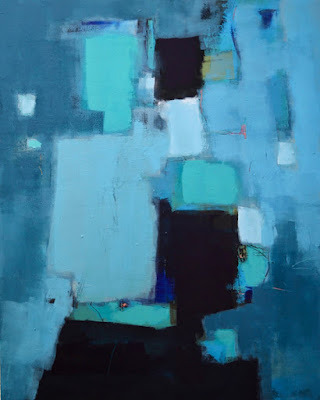 | |
|
At their opening, each artist described her experience of being influenced by the wild landscape of northern countries. I had the deep sense that these places were profoundly inspiring for both women. I know that my work is also strongly influenced by remote, wide-open landscapes and I find it so difficult to describe that sense of awe in words.
I feel that painting can get closer to describing that sense of wonder than either prose or poetry. Still, I delight in finding writers and poets who stretch language into forms that approach the ineffable. And it's painting and words together that make my heart sing.
 |
| Grandfather Tree 48x48" Acrylic on panel © 2019 Barbara Shaw |
There has been much discussion and many papers written about whether painting or poetry is the stronger of the arts, or what the connection is between them. Abstraction can be a wordless way of getting to the heart of things. Da Vinci said, "Painting is poetry that is seen and poetry is painting that is felt rather than seen." Hmmmm. No one really cares about the distinction. They are both ways of connecting to the heart. I prefer both.
 |
| Oxanna Adams and Barbara Shaw at their opening |
"Language does have a unique power, and occasionally it can lead us up to its own edge, where we step from words into a greater silence". David Hinton
 |
| Oxanna Adams work from her exhibition North. |
 |
| Barbara Shaw's work from her exhibition North. |
Both Oxanna and Barbara, in their exhibition, North, responded deeply to the landscapes that inspire them, their images conversing in a quiet, honest way with one another and the audience, describing the ineffable in paint.
Go deeper
Past thought
Into silence
Past silence
Into stillness
Deeper still
Past stillness
Into the Heart
Now
Let the Love
Consume
Whatever is left
of you
-Chris McCombs
Thank you for this, Janice.
ReplyDeleteI enjoyed this post about the painters of northern places. They had differing styles, but both were beautiful and certainly authentic.
ReplyDeleteI have been thinking about wht art form is best able to express the inner response to nature, and I think that it is music. Music goes straight to the heart. Painting and Poetry - they need to be processed in our minds - but music no. Straight to the heart.
I used to be a classical musician - taught piano for years to young people and enjoyed that. But what I wanted to do myself, was work with cloth and minimalism and the sense of touch. I hope that these things also go straight to the heart - I do think that touch is the mother of the senses. Thanks for your blog, Janice. I love it. xoxo